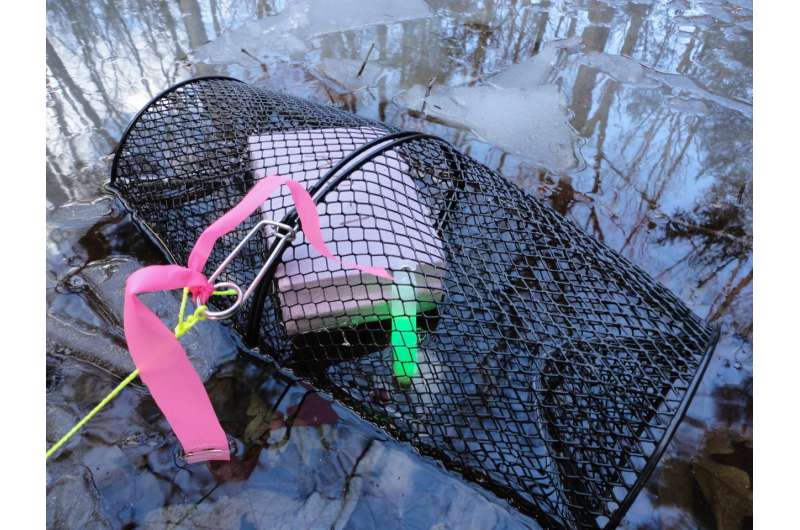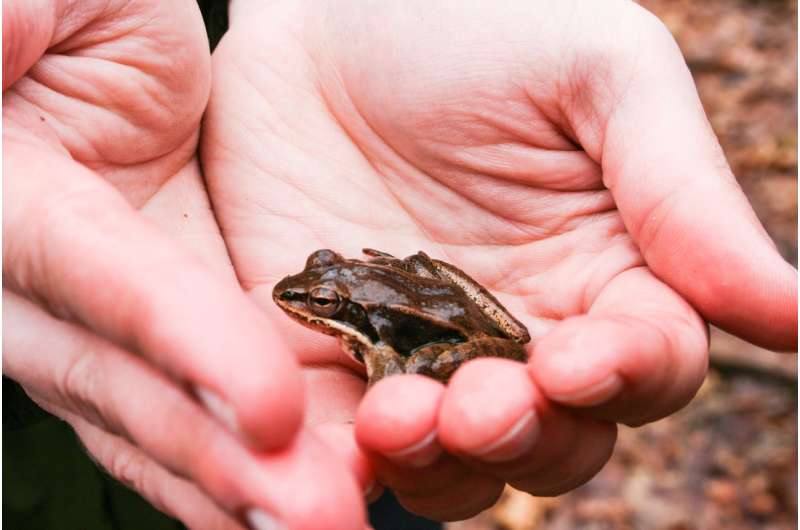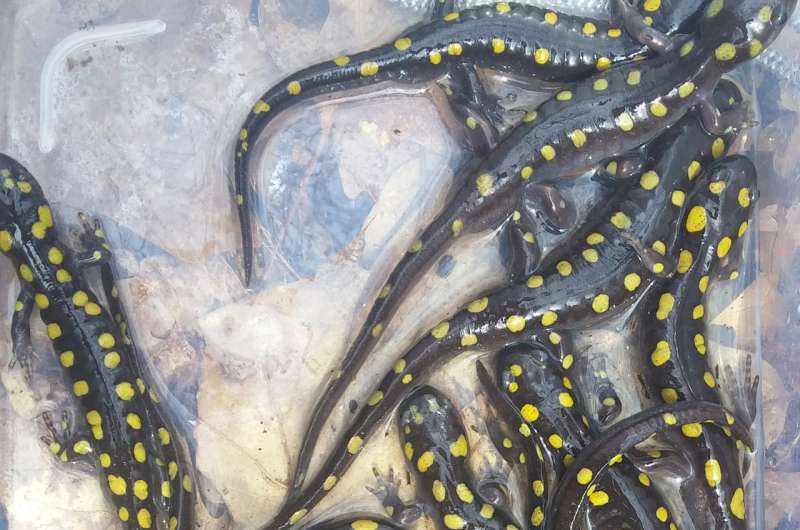Use of glow sticks in traps greatly increases amphibian captures in study

With amphibian populations declining around the world and funds to find the causes scarce, a team of Penn State researchers has shown that an unorthodox tactic will make it easier and therefore less expensive to capture adult salamanders and frogs.
The researchers demonstrated that glow sticks—cheap, self-contained, short-term light-sources—attract the creatures to traps set in vernal pools where they come to reproduce in the spring. The translucent plastic tubes contain isolated substances that, when combined, make light through chemiluminescence.
Often used for recreation, glow sticks are sometimes relied upon for light during military, police, fire or emergency operations. However, they have not been widely used in wildlife research and their appeal to amphibians is not well understood, according to David Miller, assistant professor of wildlife population ecology, College of Agricultural Sciences.
"This work is important because research funding is often limited, especially when we're talking about amphibians and reptiles compared to mammals or other charismatic species," he said. "With a warming climate, monitoring data will become only more important for informing conservation decisions. If we can find a way to improve our capture rate, it is going to mean less time, effort and expense to study amphibians."

As part of a long-term national study, Miller's lab has been monitoring amphibian populations at sites around Pennsylvania. Spearheading that effort has been David Munoz, doctoral degree candidate in ecology, who helped create the Salamander Population Adaptation Research Collaboration Network, or SPARCnet. It was his idea to "bait" traps with glow sticks at one site as an experiment. The researchers chose State Game Land 176 in Centre County, managed by the Pennsylvania Game Commission. The research using glow sticks took place in a forested area known as the Scotia Barrens, which contains a dense network of vernal pools where Miller's lab has been monitoring amphibian populations for years.
Within this network, researchers surveyed 12 pools, varying in size but with similar habitat characteristics—no aquatic vegetation and leaf-litter bottoms. Each pool dries mid- to late-summer in most years. Surveys for this experiment were conducted in March and April 2015, and traps were continuously deployed during surveys.
Over the course of nine trapping nights, researchers captured 4,935 amphibians. Glow sticks increased the average number of captures of spotted salamanders by more than three times, Jefferson salamanders by nearly four times, wood frogs by almost three times and Eastern newts by as much as six times, compared to control traps.
The research, which was published in Herpetological Review, focused on adult amphibians, noted lead researcher Michael Antonishak, an undergraduate majoring in wildlife and fisheries science when the study was done. He worked closely with Munoz on the project.

Past studies found that baiting traps with glow sticks increased the capture rates of larval amphibians two to eight times compared to funnel traps with no lure, but no studies have tested the effectiveness of glow-stick lures on the capture rates of adult, vernal pool-breeding amphibians, Antonishak pointed out.
"We specifically focus on the adult stage of amphibians because life history suggests adults play the most critical role in population persistence," he said. "Capturing adults also make techniques such as mark-recapture feasible, providing estimates of abundance and survival to improve conservation decisions."
Why are glow sticks effective lures for capturing amphibians? Researchers are not sure, Munoz admitted. It is likely a straightforward visual cue, but it could be more than that.
It is generally accepted that amphibians do not eat while they are breeding but it is possible that the light actually attracts different organisms that the amphibians may eat—perhaps the amphibians are gravitating toward those species, he explained.
"Without actually testing that, we can't say for sure," Antonishak added. "Are they attracted to the light itself or is it possible that the amphibians just see a little better in the pool where glow sticks are illuminating the water? Perhaps females, for instance, see males a little better and they are more attracted to them."
Provided by Pennsylvania State University



















